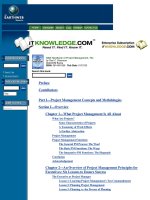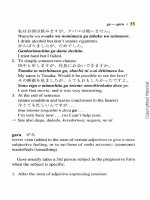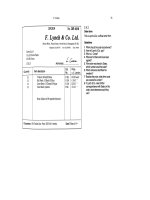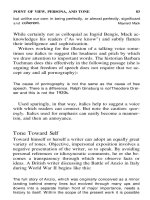THE AMA HANDBOOK OF BUSINESS WRITING phần 3 pdf
Bạn đang xem bản rút gọn của tài liệu. Xem và tải ngay bản đầy đủ của tài liệu tại đây (6.97 MB, 61 trang )
Example: Wilson, Kevin. “Formatting a Bibliography.” Writing Toolkit.
2010. Retrieved May 15,
2011.
Billion
A billion is equal to a thousand millions (1,000,000,000). You can write the
number in words or numbers:
Example: five billion dollars, $5 billion
Biweekly, Bimonthly, Semiweekly, Semimonthly
To use these terms correctly, consider the following definitions:
■ Biweekly means that something occurs every two weeks.
■ Semiweekly means that something occurs twice in one week.
■ Bimonthly means that something occurs every two months.
■ Semimonthly means that something occurs twice in one month.
Blind
See Visually Impaired, Blind.
Blog, Weblog
Blog and Weblog are synonymous terms that describe Web-based journals.
Blog can be both a noun and verb.
■ Blog as a noun refers to the Web site where the content is published.
■ Blog as a verb means to write articles for a blog.
95Section 2 The Business Writer’s Alphabetical Reference
Bold Fonts
Bold fonts are often used to identify key terms or phrases when writing tech-
nical documents or manuals. Consider the following tips for using bold
fonts:
■ Use bold fonts for emphasis to make certain words or phrases
stand out.
■ Use bold fonts for headlines and headings in your documents.
■ In procedural documents, use bold fonts for warning or caution
messages.
■ Don’t add bold to an entire paragraph of text.
■ Use the bold font version of the typeface rather than the bold style
function (the bold button) of your software. Use the bold style
function only as a last resort if there is no bold typeface for the
font you are using.
Bored, Boring
Bored is an adjective that describes when someone is uninterested, unhappy,
or unoccupied.
Example: He was so bored that he started reading the phone book.
Boring is an adjective that means something is not interesting or exciting.
Example: The seminar was so boring that he fell asleep.
Both, Alike
Don’t use the combination both alike.
Incorrect: The cars are both alike.
Correct: The two cars are alike. They are both the latest model.
96 The AMA Handbook of Business Writing
Both, Each
Both is used to describe a condition that applies to two entities. Each is used
to describe a single entity.
Incorrect: There is a picture on both sides of the mantel.
Correct: There is a picture on each side of the mantel.
Brackets
Brackets and parentheses are sometimes used interchangeably.
Changes to Quoted Material
If you are quoting someone, but make a change to the quote for clarity, you
should put your change within brackets. Consider the following:
Original quote: “Everyone knew it was about to break any day now.”
Revised quote: “Everyone knew it [the dam] was about to break
any day now.”
Digressions Within Parentheses
Sometimes you will find situations where you need an extra set of parenthe-
ses nested within a previous pair.
Example: The computer’s memory (random access memory [RAM]
and read only memory [ROM]) is where software is loaded.
Brake, Break
A brake as a noun means a device that slows a vehicle.
Example: I had to push hard on the brake to stop.
97Section 2 The Business Writer’s Alphabetical Reference
Break can be a noun or a verb.
■ Break as a verb means to damage something.
Example: He is going to break the chair.
■ Break as a noun means time off.
Example: I want to go outside on my break.
Brand Names
Capitalize the brand names of products. Some common brand names like
Kleenex, Xerox, and Band-Aid are trademarked brand names and should be
capitalized. You do not need to use the symbols ® or ™ when writing brand
names.
If the product is part of the brand name, then it is also capitalized.
Example: Wonder Classic White Bread
If the product is not part of the brand name, then the product is not capitalized.
Example: Listerine mouthwash
Breath, Breathe
Breath is a noun that describes the air passing into and out of our lungs.
Example: The yoga teacher asked us to focus on our breath.
Breathe is a verb meaning to take a breath.
Example: Close your eyes, breathe deeply, and relax.
98 The AMA Handbook of Business Writing
Bring, Take
Bring is used to denote movement toward someone or something. Take is
used to denote movement away from someone or something.
Example: Bring me the book.
Example: Take the book to him.
British English
See American English, British English.
Bulleted List
Bulleted lists draw attention to important information. Consider these tips
for the use of bulleted lists:
■ Use a numbered list for a sequence of events or ranking items in a list.
■ Use bullet symbols or checkmarks when the items in the list are not
sequential or ranked.
■ Make all the entries grammatically parallel.
■ Do not mix clauses and sentences when creating bullet points.
■ If the bullet points are not complete sentences, they do not need end
punctuation.
■ Indent subtext bullets that provide additional details about a main
bullet point.
Bushel
Add an s when referring to more than one bushel.
Incorrect: Eight bushel of oats.
Correct: Eight bushels of oats.
99Section 2 The Business Writer’s Alphabetical Reference
Business, Right
Don’t use business when you really mean right.
Incorrect: What business is it of theirs to question my action?
Correct: What right have they to question my action?
Buzzwords
Buzzwords are popular overused words that are common in business envi-
ronments. Buzzwords are often pretentious and difficult to understand. Avoid
them in your business writing.
Some buzzwords may be appropriate in the right context:
Incorrect: We need to architect a software solution.
Correct: John is the architect on the building project.
Common buzzwords to avoid are shown in Table 2.7.
Table 2.7 Common Buzzwords to Avoid
accountability action items architect ballpark
benchmarking best of breed best practice big picture
bleeding edge bottom line business case buy-in
champion cross-platform customer-focused deliverables
downsize drill down empowerment enterprise-wide
fast track front-end game plan globalize
goal-oriented going forward heads up heavy lifting
herding cats ideation in the loop in-market for
info superhighway intellectual capital key player knowledge base
leading edge lean and mean level-set leverage
long-term low-risk/high-yield matrix methodology
100 The AMA Handbook of Business Writing
mind-set mission-critical mission statement monetize
multitasking networking on the same page out-of-the-loop
out-of-the-box outside the box oxymoron paradigm shift
partner peel the onion performance- play hardball
based
power shift push the envelope ramp up reality check
re-engineer resource- results-driven right-size
constrained
risk management ROI (return on rubber stamp scalable
investment)
service stand-alone synergize take that offline
organization
talking points task force think outside tip of the iceberg
the box
total quality touch base touch points train wreck
turnkey 24/7 user-centric value-added
whiteboard win-win world-class
By,Bye,Buy
By is a preposition and is commonly used in prepositional phrases.
Example: You should have learned that by now.
Bye is an abbreviated form of good-bye or a break in a sports team schedule.
Example: Because we had the best record, we got a bye for the first
round of the tournament.
Buy can be both a noun and a verb. As a noun, buy means a very affordable
purchase.
Example: The sweater was a great buy.
101Section 2 The Business Writer’s Alphabetical Reference
Buy as a verb means to make a purchase.
Example: I’m going to buy the sweater.
By, Until
By and until both indicate any time before, but not later than, a certain time.
Until is used to tell how long a situation continued.
Example: He lived in Austin until May 2010.
Until is often used in negative sentences.
Example: Tickets will not go on sale until January 15.
By is used when something will happen before or at a specific time. It is often
used to indicate a deadline.
Example: You have to finish the project by December 31.
102 The AMA Handbook of Business Writing
C
Call Back, Callback
Call back is two words when used as a verb.
Example: I need to call back two of the top candidates for the
position.
Callback is one word when used as a noun or adjective.
Example: After the audition, Chaital hoped for a callback.
Call Out, Callout
Call out is two words when used as a verb.
Example: You should call out the processes in the diagram.
Callout is one word when used as a noun or adjective.
Example: The illustration had a callout created as a text box.
Callouts
Callouts are text labels in an illustration that point out specific items that
should be noticed by the reader. (See Figure 2.1.) Consider the following tips
for using callouts:
■ Callouts should have the first letter capitalized.
■ Do not capitalize callouts that start with an ellipsis (…).
■ If the callout is a complete sentence, end it with a period.
103
■ Avoid a group of callouts for a single illustration where some are
complete sentences and others are sentence fragments.
■ Make all the callouts consistent grammatically for a single illustration.
Figure 2.1 Illustration with Callouts
Came By
Came by is a colloquial phrase and should be avoided in business writing.
Incorrect: He came by to see me.
Correct: He came to see me.
Can, May
Use can to indicate capability.
Example: Can you read the bottom line on the eye chart?
Example: Yes, I can read it.
Use may to indicate possibility or when asking for permission.
Example: It may rain today.
104 The AMA Handbook of Business Writing
Example: May I help you?
Cannot
Cannot is one word.
Incorrect: We can not make it to the performance.
Correct: We cannot make it to the performance.
Can’t Seem
Seem is a verb that means look or appear. Using can’t with seem is awkward.
Incorrect: I can’t seem to make the journey in an hour.
Correct: It seems impossible for me to make the journey in one hour.
Canvas, Canvass
A canvas is a noun that means a heavy cloth that is, for example, stretched
on a wood frame for painting or used to cover the floor of a boxing ring.
Example: The artist applied paint to the canvas.
Example: After the devastating punch, the unconscious boxer fell to
the canvas.
Canvass is a verb meaning to survey.
Example: We went door-to-door to canvass voters.
105Section 2 The Business Writer’s Alphabetical Reference
Capital Letters
Capital letters are used at the beginning of a sentence or for a proper noun.
Capital letters are also called upper case.SeeCapitalization.
Capital, Capitol
Capital can be a noun or an adjective. Capital:
■ Can be the seat of government for a state or country.
■ Can be an uppercase letter.
■ Can be money or property owned by a business.
■ Can be the top part of an architectural column.
■ Can also mean “punishable by death.”
Example: Murder is a capital offense.
■ Capital, as an adjective, means principal or chief.
Example: It was the capital idea of the conference.
Capitol is the building where the U.S. Congress meets. It is capitalized when
it refers to the U.S. Capitol. It is not capitalized when it refers to the main
government building for a U.S. state.
Capitalization
Proper nouns that denote the names of specific persons or places are capital-
ized, though names that are common to a group are not. Consider the follow-
ing capitalization guidelines:
Acts of Congress
■ Civil Rights Act
■ Taft-Hartley Act
106 The AMA Handbook of Business Writing
■ Child Labor Amendment
■ Eighteenth Amendment
Associations
■ Society of Professional Engineers
■ American Business Association
■ Young Women’s Christian Association
■ American Heart Association
Book Titles and Their Subdivisions
■ The American Way, Chapter VI
■ Remembrance of Things Past, Volume 11
■ Bulletins and Periodical Titles
■ Wall Street Journal
Railroad Cars and Automobile Models
■ Car 54, Train 93
■ Plymouth
■ Cadillac
Churches and Church Dignitaries
■ Fifth Avenue Presbyterian Church
■ the Archbishop of New York
■ Bishop John Barnes
Cities
■ Jefferson City, Missouri
■ Los Angeles
107Section 2 The Business Writer’s Alphabetical Reference
Clubs
■ Leon Book Club
■ The Do-Gooders
■ Union League Club
■ But: many Republican clubs in the West
Legal Codes
■ the Code of Building Maintenance
■ But: the building code
■ Code VI
Compass Points Designating a Specific Region
■ the Northeast [section of the country]
■ the Pacific Northwest
■ But: just drive north
■ the West
■ But: west of town
Constitutions
■ the Constitution of Texas
■ the Constitution of the United States
■ But: the constitution of any nation
Corporations
■ American Brake Corporation
■ Container Corporation of America
■ But: The corporation was dissolved.
108 The AMA Handbook of Business Writing
Courts
■ the Criminal Court of Appeals
■ But: a court of appeals
■ the Supreme Court
■ the Magistrate’s Court
■ But: a county court
Decorations
■ Purple Heart
■ Good Conduct Medal
■ Croix de Guerre
■ But: Soldiers are given decorations to signal their acts of heroism.
Degrees (Academic)
■ B.A.
■ D.D.
■ M.D.
■ Ph.D.
Districts
■ First Congressional District
■ But: a congressional district
Educational Courses
■ English 101
■ Spanish Grammar
■ Mathematics Made Easy
■ But: He is studying physics and chemistry.
109Section 2 The Business Writer’s Alphabetical Reference
Epithets
■ First Lady of the State
■ Alexander the Great
Fleets
■ the Third Fleet
■ But: The ship was part of the fleet.
Foundations
■ Carnegie Foundation
■ Isha Foundation
■ But: He established a foundation.
Geographic Divisions
■ Lone Star State
■ Sooner State
■ But: There are fifty states in our country.
■ Northern Hemisphere
■ South Pole
■ Old World Near East
Government Divisions
■ Federal Reserve Board
■ the Boston Fire Department
■ But: The department was headed by Mr. Brian Wilson.
Historical Terms
■ Dark Ages
■ Renaissance
110 The AMA Handbook of Business Writing
■ Christian Era
■ World War II
■ Battle of the Bulge
■ Declaration of Independence
■ Magna Carta
Holidays
■ Thanksgiving Day
■ Passover
■ Easter Sunday
■ New Year’s Eve
Libraries
■ Library of Congress
■ Albany Public Library
■ But: The library is a source of information.
Localities
■ Western Europe
■ East Africa
■ Wheat Belt
■ West Side
■ Mississippi Delta
Military Services
■ United States Navy
■ Signal Corps
■ Second Battalion
111Section 2 The Business Writer’s Alphabetical Reference
■ Company B
■ Squadron 28
Nobility and Royalty
■ Queen of Belgium
■ But: Many queens were honored here.
■ Duke of Windsor
■ But: She was proud to have met a duke.
Oceans and Continents
■ Pacific Ocean
■ But: He was glad to be crossing the ocean.
Parks, Peoples, and Tribes
■ Greenleaf Park
■ Lake Texoma State Park
■ Yellowstone National Park
■ But: The park was in a southern state.
■ Jews
■ Christians
■ Malay
■ Chickasaw
Personification
■ He was recognized by the Chair and spoke briefly.
■ He sang about Summer in all its glory.
■ But: In summer the days are longer.
112 The AMA Handbook of Business Writing
Planets and Other Heavenly Bodies
■ Mars
■ Venus
■ Big Dipper
Exceptions: moon, sun, stars
Rivers
■ Mississippi River
■ Wabash River
■ But: The Mississippi and Wabash rivers were flooding after the
torrential rains.
Sports Stadiums, Teams, and Terms
■ Dallas Cowboys
■ Madison Square Garden
■ Super Bowl
■ Dodgers
Captions
A caption is a short text message that appears below an illustration in a doc-
ument that names and describes the image. A caption is usually placed direct-
ly below the illustration. Good captions pull a reader into the document.
A good caption should:
■ Identify the subject of the illustration.
■ Be short.
■ Establish the relevance to the document.
113Section 2 The Business Writer’s Alphabetical Reference
Cardinal and Ordinal Numbers
Numerical symbols like 1, 2, 3 or numbers written as words like one, two,
three are cardinal numbers.
Ordinal numbers express an order.
Example: first, second, third …
Case
Case is a grammatical term that refers to how nouns and pronouns are used
with other words in a sentence. There are three cases:
■ Subjective
■ Objective
■ Possessive
The subjective case is also called the nominative case. Subjective case
includes:
■ When a noun or pronoun is the subject of a sentence
Example: I [pronoun] plan to go to India.
Example: Mike [proper noun] sings in a band.
■ When a predicate noun is used (a noun following a form of the
be verb)
Example: He is a singer [a predicate noun].
The objective case is used when the noun or pronoun is used in a sentence
as a direct object, an indirect object, or the object of a preposition.
Example: Carl drew the picture [direct object].
114 The AMA Handbook of Business Writing
Example: Jeff gave us [indirect object] the final presentation.
Example: Our team climbed up the stairs [objective of a preposition]
together.
The possessive case is used to show ownership by a noun or pronoun.
Example: Paul washed Nina’s [noun] clothes.
Example: Where did you find her [pronoun] clothes?
Table 2.8 provides a list of pronoun cases.
Table 2.8 Pronoun Cases
Subjective Objective Possessive
I me my, mine
you you your, yours
he him his
she her her, hers
it it its
we us our, ours
they them their, theirs
Cataphora
Cataphora is a writing technique that uses words or phrases such as pro-
nouns to point forward to something later in the text.
Example: Since he was afraid of it [points forward to the noun
“ocean”], John found it very difficult to go near the ocean.
115Section 2 The Business Writer’s Alphabetical Reference
Causative Verbs
Causative verbs are used to describe an action that is necessary to cause
another action.
Example: My manager made me do it.
Other examples: let, make, help, allow, have, require, motivate,
get, convince, hire, assist, encourage, permit, employ, force
Causative verbs are usually followed by an object (noun or pronoun) and an
infinitive (to plus a verb).
Example: He allows his staff to work from home every Friday.
Three causative verbs do not follow this pattern: have, make, let. These verbs
are usually followed by an object and the base form of the verb.
Example: She made her clients read the entire contract.
Caution Notice
See Notices.
CD, DVD
CD stands for compact disc. CD-ROM stands for compact disc, read-only
memory. DVD stands for digital video disc. Do not add disc after CD or
DVD.
Incorrect: Please give me the CD disc.
Correct: Please give me the DVD.
116 The AMA Handbook of Business Writing
Censor, Censure, Sensor, Censer
Censor means to suppress someone’s speech or writings to prevent them
from being shared.
Example: The producer had to censor the interview by bleeping
inappropriate language from the broadcast.
Censure means to denounce an offender.
Example: The lawyer who tampered with evidence was censured by
the bar association.
A sensor is a device that detects changes in the environment.
Example: A motion sensor turns the light on when someone goes by.
A censer is an incense burner in a church.
Example: The priest swings the censer three times.
Champaign, Champagne
Champaign is a city and county in Illinois. Champagne is a type of sparkling
wine and a region in France.
Check, Control
To check means to make certain something is correct, safe, or suitable by
examining it.
Example: You should always check your wiper blades whenever you
change your car’s oil.
117Section 2 The Business Writer’s Alphabetical Reference
To control means to limit, order, instruct, or rule something or someone’s
actions.
Example: You need to control your dog while walking in the park.
Chiasmus
A chiasmus is a figure of speech created when two clauses use a reversal of
structures. A chiasmus is often used to make a larger point.
Example: “Fair is foul, and foul is fair.”—William Shakespeare
Chicano, Latino, Hispanic
To use these terms correctly in your writing, consider the following defini-
tions:
■ Chicano means Mexican-American.
■ Latino means having Latin American heritage.
■ Hispanic means having heritage from a Spanish-speaking country.
Choose, Chose
Choose is the present tense.
Example: Which one are you going to choose?
Chose is the past tense.
Example: I chose the purple one.
118 The AMA Handbook of Business Writing
Cite, Site, Sight
To cite is a verb meaning to reference another person’s words or writing.
Example: You cite the poet in your report.
A site is a noun meaning a location.
Example: That is the site of the car wreck.
Example: This is my Web site.
Sight can be a noun or a verb. As a noun, sight means the perception of some-
thing with your eyes, a view, or a glimpse.
Example: The ocean is in sight.
Sight as a verb means to see or to take notice.
Example: He sighted the enemy in his binoculars.
Citing Publications
Sources are often used in the creation of a new business document. Cited
sources appear within the text and in a reference list at the end of the doc-
ument.
■ Within the text, insert the last name of the author, a comma, and the
publication date in parentheses.
Example: (Stroman, 2011)
■ For multiple authors, cite both names joined with an ampersand (&), a
comma, and the publication date in parentheses.
Example: (Stroman & Wauson, 2011)
119Section 2 The Business Writer’s Alphabetical Reference









